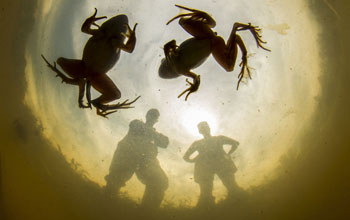
Scientists peer into a pond containing amphibians with deformed limbs.
Credit: Dave Herasimtschuk/Freshwaters Illustrated
Download the high-resolution JPG version of the image. (134 KB)
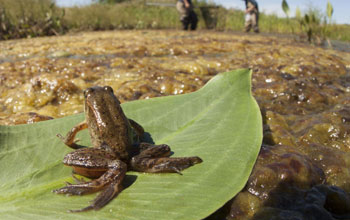
A northern red-legged frog with limb deformities seems to watch researchers at work.
Credit: Dave Herasimtschuk/Freshwaters Illustrated
Download the high-resolution JPG version of the image. (215 KB)
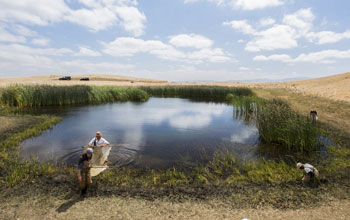
Scientists search ponds for deformed amphibians.
Credit: Dave Herasimtschuk/Freshwaters Illustrated
Download the high-resolution JPG version of the image. (205 KB)
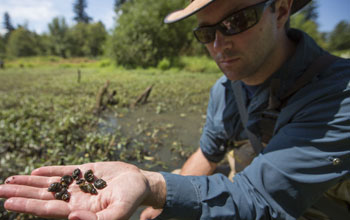
Biologist Piet Johnson collects snails for parasite testing.
Credit: Dave Herasimtschuk/Freshwaters Illustrated
Download the high-resolution JPG version of the image. (150 KB)
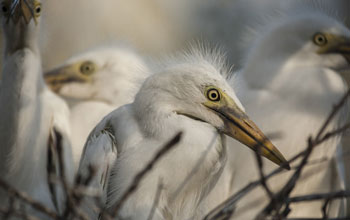
Amphibian-eating birds such as herons and egrets are part of the aquatic parasite cycle.
Credit: Dave Herasimtschuk/Freshwaters Illustrated
Download the high-resolution JPG version of the image. (107 KB)
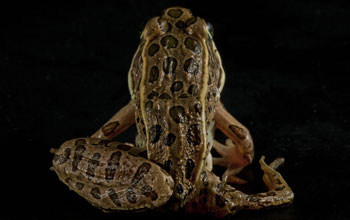
This northern leopard frog has deformed limbs from a parasite infection.
Credit: Dave Herasimtschuk/Freshwaters Illustrated
Download the high-resolution JPG version of the image. (145 KB)
The richer the assortment of amphibian species in a pond, the more
protection that community of frogs, toads and salamanders has against a
parasitic infection that can cause severe deformities, including the
growth of extra legs.
The findings, published in a paper in this week's issue of the journal Nature,
support the idea that greater biodiversity in large-scale ecosystems,
such as forests or grasslands, may also provide greater protection
against diseases, including those that affect humans.
A larger
number of mammal species in an area may curb cases of Lyme disease,
while a larger number of bird species may slow the spread of West Nile
virus.
"How biodiversity affects the risk of infectious diseases,
including those of humans and wildlife, has become an increasingly
important question," said Pieter Johnson, an ecologist and evolutionary
biologist at the University of Colorado Boulder, and the lead author of
the paper.
"But as it turns out, solidly testing these links with realistic experiments has proven very challenging in most systems."
Researchers
have struggled to design comprehensive studies that could illuminate
the possible connection between disease transmission and the number of
species living in complex ecosystems.
Part of the problem is the
enormous number of organisms that may need to be sampled, and the vast
areas over which those organisms may roam.
This study overcame that problem by studying smaller, easier-to-sample ecosystems, the scientists say.
"The
research reaches the surprising conclusion that the entire set of
species in a community affects susceptibility to disease," said Doug
Levey, program director in the National Science Foundation (NSF)'s
Division of Environmental Biology, which funded the research.
"Biodiversity matters."
Johnson and colleagues visited hundreds of
ponds in California, recording the types of amphibians living there as
well as the number of snails infected by the pathogen Ribeiroia ondatrae.
Snails are an intermediate host used by the parasite during part of its life cycle.
"One
of the great challenges in studying the diversity-disease link has been
collecting data from enough replicate systems to differentiate the
influence of diversity from background 'noise,'" Johnson said.
"By
collecting data from hundreds of ponds and thousands of amphibian
hosts, we were able to provide a rigorous test of this hypothesis, which
has relevance to a wide range of disease systems."
The
researchers buttressed field observations with laboratory tests
designed to measure how prone to infection each amphibian species is,
and by creating pond replicas using large plastic tubs stocked with
tadpoles that were exposed to a known number of parasites.
All the experiments told the same story.
Greater biodiversity reduced the number of amphibian infections and the number of deformed frogs.
The
scientists spent three years sampling 345 wetlands and recording
malformations--which include missing, misshapen or extra sets of hind
legs--caused by parasitic infections in 24,215 amphibians.
The
results showed that ponds with half a dozen amphibian species had a 78
percent reduction in parasite transmission compared to ponds with just
one amphibian species.
The reason for the decline in parasitic
infections as biodiversity increases is likely related to the fact that
ponds add amphibian species in a predictable pattern, with the first
species to appear being the most prone to infection and the later
species to appear being the least prone.
The researchers found
that in a pond with just one type of amphibian, that amphibian was
almost always the Pacific chorus frog, a creature that's able to rapidly
reproduce and quickly colonize wetland habitats, but which is also
especially vulnerable to infection and parasite-induced deformities.
On
the other hand, the California tiger salamander was typically one of
the last species to be added to a pond community--and also one of the
most resistant to parasitic infection.
Therefore, in a pond with
greater biodiversity, parasites have a higher chance of encountering an
amphibian that is resistant to infection, lowering the overall success
rate of transmission between infected snails and amphibians.
This
same pattern--of less diverse communities being made up of species that
are more susceptible to disease infection--may well play out in more
complex ecosystems, Johnson said.
That's because species that
disperse quickly across ecosystems appear to trade off the ability to
quickly reproduce with the ability to develop disease resistance.
The recent study also reinforces the connection between deformed frogs and parasitic infection.
In
the mid-1990s reports of frogs with extra, missing or misshapen legs
skyrocketed, attracting widespread attention in the media and motivating
scientists to try to figure out the cause.
Johnson was among the researchers who found evidence of a link between infection with Ribeiroia and frog deformities, though the apparent rise in reports of deformations, and its underlying cause, remained controversial.
While
the new study has implications beyond parasitic infections in
amphibians, it does not mean that an increase in biodiversity always
results in a decrease in disease, Johnson said.
Other factors also affect rates of disease transmission.
For
example, a large number of mosquitoes hatching in a particular year
increases the risk of contracting West Nile virus, even if there has
been an increase in the biodiversity of the bird population.
Birds
act as "reservoir hosts" for West Nile virus, harboring the pathogen
indefinitely with no ill effects, then passing on the pathogen.
"Our results indicate that higher diversity reduces the success of pathogens in moving between hosts," Johnson said.
"But
if infection pressure is high, there will still be a significant risk
of disease. Biodiversity will simply dampen transmission success."
Co-authors
of the paper are Dan Preston and Katie Richgels of the University of
Colorado Boulder, and Jason Hoverman of Purdue University.
In addition to NSF, the research was funded by the National Geographic Society and the David and Lucile Packard Foundation.
-NSF-
Media Contacts
Cheryl Dybas, NSF (703) 292-7734 cdybas@nsf.gov
Laura Snider, University of Colorado Boulder (303) 735-0528 laura.snider@colorado.edu
Laura Snider, University of Colorado Boulder (303) 735-0528 laura.snider@colorado.edu
Related WebsitesNSF Special Report: Ecology and Evolution of Infectious Diseases: http://www.nsf.gov/news/special_reports/ecoinf/index.jsp
The National Science Foundation (NSF) is an independent federal
agency that supports fundamental research and education across all
fields of science and engineering. In fiscal year (FY) 2012, its budget
is $7.0 billion. NSF funds reach all 50 states through grants to nearly
2,000 colleges, universities and other institutions. Each year, NSF
receives over 50,000 competitive requests for funding, and makes about
11,000 new funding awards. NSF also awards nearly $420 million in
professional and service contracts yearly.
Useful NSF Web Sites:
NSF Home Page: http://www.nsf.gov
NSF News: http://www.nsf.gov/news/
For the News Media: http://www.nsf.gov/news/newsroom.jsp
Science and Engineering Statistics: http://www.nsf.gov/statistics/
Awards Searches: http://www.nsf.gov/awardsearch/
NSF Home Page: http://www.nsf.gov
NSF News: http://www.nsf.gov/news/
For the News Media: http://www.nsf.gov/news/newsroom.jsp
Science and Engineering Statistics: http://www.nsf.gov/statistics/
Awards Searches: http://www.nsf.gov/awardsearch/
Guillermo Gonzalo Sánchez Achutegui
ayabaca@gmail.com
ayabaca@hotmail.com
ayabaca@yahoo.com
Inscríbete en el Foro del blog y participa : A Vuelo De Un Quinde - El Foro!

No hay comentarios:
Publicar un comentario